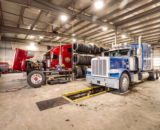/// Guest post by contributor Bill Buzbee, Terra Environmental Technologies (TET), a CF Industries Co.
The demand for diesel exhaust fluid (DEF) is on the rise and truckstop and travel plaza operators are responding by stocking jugs and offering bulk DEF at the pumps. As they evaluate their options for adding this new service they have many questions. To help operators prepare, we've answered a question recently asked of us by a NATSO member below. Read more blog posts on DEF here.
Q: What is the difference between diesel engines with exhaust gas recirculation (EGR) and selective catalytic reduction (SCR)? Are more trucks using SCR engines or EGR?
A: There have been two approaches to regulatory compliance: EGR and SCR. EGR was implemented January 1, 2007 and SCR was implemented January 1, 2010. EGR was able to meet the Federal Standards for 2007, but not able to meet the new standards for 2010.
In 2007 the Emissions Standard was 1.2 NOx (g/hp.pr) and it could be reached using EGR technology, but January 1, 2010 this standard dropped to .02g/HP-hr NOx and .01 g/HP-hr particulate matter. EGR technology could not meet this standard for large diesel engines. Several tried to enhance EGR, but fell short of reaching the new standard. SCR became the technology for all new vehicle production.
EGR: How It Works
EGR or Exhaust Gas Recirculation recirculates exhaust gases back into the cylinder and burns them again.
A portion of the exhaust gases are first cooled through a heat exchanger and then blended with fresh air before being returned to the cylinder. The exhaust gases have less oxygen and more carbon dioxide than the rest of the incoming air. This lowers the combustion temperature, which results in reduced nitrogen oxides (NOx). The challenge is to reduce the temperature without having an excessive impact on combustion efficiency.
This approach involves extensive exhaust gas cooling systems, recirculation valves to divert a portion of the exhaust or ultra- high pressure injection, and a diesel particulate filter (DPF), which needs active regeneration to avoid blockages which leads to higher fuel consumption. EGR also increases ash and soot in the oil.
SCR: How It Works
With SCR or Selective Catalytic Reduction, the nitrogen oxide (NOx) reduction process takes place after combustion - so as to not diminish engine performance.
The process is simple: diesel exhaust fluid (DEF) is sprayed into the hot exhaust gases. The fluid consists of urea and deionized water. This mixture passes through a catalytic chamber.
When the hot exhaust combines with the DEF within the catalytic chamber, the exhaust is broken down into harmless nitrogen and water vapor - two natural components of the air we breathe.
The bottom line with EGR is it adds cost, complexity, hotter running performance and increased engine noise.
Fleets were slow to adopt yet another technology especially after the impact of the EGR engines that reduced fuel mileage and added maintenance cost. In 2010 US fleets had reached a 20-year high in vehicle age at approximately 6.9 years. But, now they are ordering new SCR vehicles and they are growing rapidly. There were approximately 400 SCR equipped Class 8 vehicles at the end of 2012. Effective the first of this year 2013 100% of all diesel on-road vehicles are utilizing SCR technology.
/// Read more blog posts on DEF here.
Editor's note: Do you have another DEF question? Reach out to us at editor@natso.com and with the help of Terra Environmental Technologies, we'll answer it here on NATSO's blog. - AT
{Guest Post} Guest post provided by Bill Buzbee, Terra Environmental Technologies (TET), a CF Industries Co. CF Industries, the largest North American manufacturer of DEF, makes TerraCair®, the choice of leading truck manufacturers for their factory fills and dealerships. CF Industries makes it and oversees the entire distribution chain to ensure product quality in your tank. Leading truck manufacturers depend on TerraCair. You can too! Learn more about Terra Environmental Technologies (TET), a CF Industries Co.
The opinions and advice given by guest post contributors are not necessarily those of NATSO Inc. The posts should not be considered legal advice. Qualified professionals should be sought regarding advice and questions specific to your circumstances.
Subscribe to Updates
NATSO provides a breadth of information created to strengthen travel plazas’ ability to meet the needs of the travelling public in an age of disruption. This includes knowledge filled blog posts, articles and publications. If you would like to receive a digest of blog post and articles directly in your inbox, please provide your name, email and the frequency of the updates you want to receive the email digest.

